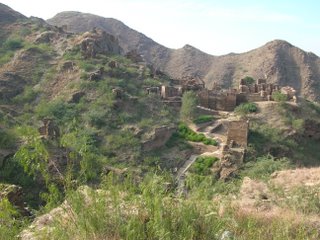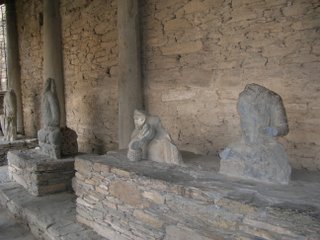A World Heritage Site in Pakistan
 In 2002, before I was to visit this special spot high up in the mountains outside Peshawar, a pair of bombs were dropped within Peshawar city limits by US helicopters. This served to heighten security within the whole region, so the trip was cancelled. Pakistan received an official apology a couple of days later which labeled the bombs ‘an unfortunate mistake’. It proved too late to reschedule our mountain visit.
In 2002, before I was to visit this special spot high up in the mountains outside Peshawar, a pair of bombs were dropped within Peshawar city limits by US helicopters. This served to heighten security within the whole region, so the trip was cancelled. Pakistan received an official apology a couple of days later which labeled the bombs ‘an unfortunate mistake’. It proved too late to reschedule our mountain visit. Collateral damage, we said, a result of being too close to the Afghan border. A large exposed crater remained not far from the hotel where I was staying, providing a whole new personal perspective to the concept of “international mistakes” and “friendly fire”. The mountain site we were meant to visit was unknown to me at that time, the name Takht-i-Bhai (which sounds like Tak By) didn’t ring any bells and there was no travel guide to consult, so I wasn’t really aware of what I was missing. It is also probably true that the proximity of the bombings was distracting and I w
 as glad enough to stay ‘close to home’, despite the obvious reminder of how dangerous “close to home” could be.
as glad enough to stay ‘close to home’, despite the obvious reminder of how dangerous “close to home” could be.The day before we leave for the mountain site this time, Maggie and I are taken to the Peshawar Museum by some friends who are unaware that we are off to visit the actual site the next day. At that point, neither of us knew we would be visiting an archaeological site or one of such significance. The tour round the museum turned out to be sheer serendipity and provides a wonderful preparation for our site visit.
The stone statues are dusty and the lighting is poor but just viewing the bits and pieces recovered from Takht-i-Bhai, I am suffused with a powerful sense of their beauty. What is even more amazing is the change in the art within the couple of hundred years on display here.

Early Buddhist art portrayed the Enlightened One with symbols alone. Although conversion and holy wars were not part of Buddhism, the message and the art still managed to spread across most of Asia between the 5th and 1st century BC. It was carried along the silk routes to India and Pakistan and across monsoon-blown sea lanes to places such as Java. King Asoka, seems to have played a central role in the development of Gandhara art about the third century BC when he not only welded India into an empire but became a Buddhist convert himself. Asoka not only helped to spread Buddhism but appears to have encouraged a two-way interaction with the flourishing Greco-Roman influences around the Mediterranean.

I don’t recall having heard much about this interplay between Asian and Greco-Roman influences and find it fascinating to contemplate. It has the same fascination for me as learning about the early contact of Ethiopians with Christians and Jews. When you look at maps of both these areas, and know something of the travel routes of the day, it rings true. It also explains a great deal about how cross cultural influences happened.
The difference between the early and later Gandhara sculptures on display is striking. The raised relief of carved animals and people dance across the stone surfaces exuberantly in the later art. I would not have attributed this to its contact with the flowing forms of Greco-Roman sculpture but it is clear a major leap forward has occurred and it looks as if Buddhist art benefited most from this exchange. It sets me to thinking why this would be so and if we might be experiencing something similar in popular culture today.

Much of the historical evidence of Buddhist life in the region, the great art and architecture from that period are gone. What remained intact after Alexander’s destruction were the magnificent stone Buddhas in Bamiyan. The sculptures of Bamiyan survived the destruction visited on other such sites because they were so isolated, so difficult to access and so little known. For many of us, the first we heard of the Afghanistan Buddhist treasures was in the form of worldwide outrage at the destruction visited on them by militants. Loss of these sites has made the ruins at Takht-i-Bhai even more precious.

The Takht-i-Bhai site has some protection as it been designated a UNESCO World Heritage site based on its historical, religious and archeological importance. The Buddhist sanctuary, monastery and school is spread over a number of mountain sites in a area of almost 40 hectares.
On the site are the remains of a main stupa and quadrangle, a number of votive stupas, monastic court yard, lofty chapels, dining hall, meditation cells, covered passages and many other secular buildings. Most of the sculptures that remained have been removed to the Peshawar Museum. Stone walls have been created with lime and mud mortar in what is known as diaper style masonry. Original stucco and ochre-painted walls can still be found.
Maggie and I are escorted to the site by two staff members from the NGO we are visiting. They are touched by our appreciation of the site. In this ancient land it is just one more evidence of antiquity for them. We climb several of the outposts, scramble over the rocks and take pictures. The site reminds me somewhat of photos I have seen of Tibetan monasteries, high up in the clouds, spread over several different hill tops. It seems monks want the solitude and value a great view. The site has been built near and named after two wells, we are told by the Pakistani guide. We pass several young Asian women with clipboards taking notes and measurements. Our guide tells us they from a Japanese university and working on their masters.

There is a guest book we are asked to sign. We flip through the back pages and note many visitors from Hong Kong and Japan. Their notes reflect the same appreciation and wonder that we have experienced. As we leave we buy a small illustrated hardcover book about the site from the Guide, glad to have some additional information.
Considering the buildings were constructed more than 800 years ago and have suffered serious attempts at destruction, the site remains remarkably alive--a touching monument to our shared and varied past.
Photos: Arial view, Peshawar Museum, Doorniche, monastary, Sole remaining Buddha, grinding stones, small pieces,
Labels: Pakistan


1 Comments:
Dropping in to wish you a safe and happy New Year ... after reading this post, the accent on that wish is SAFE!!! :o)
Post a Comment
<< Home